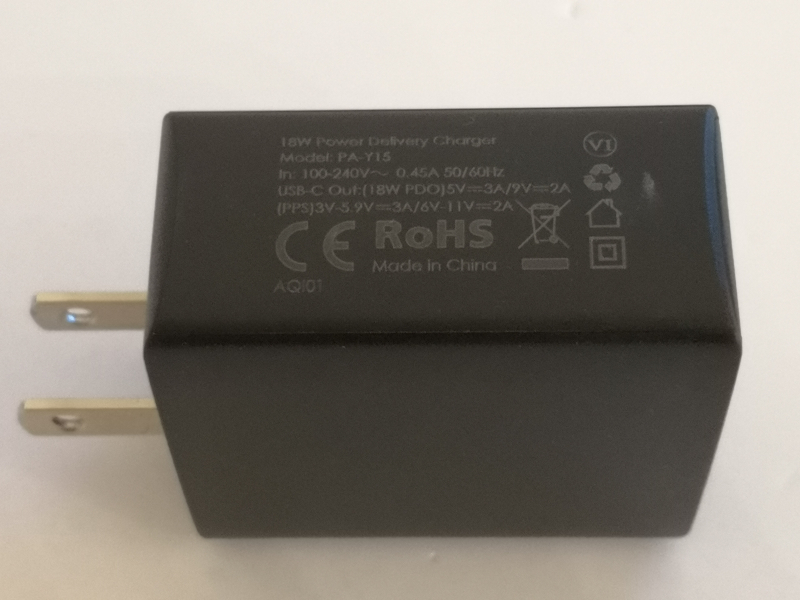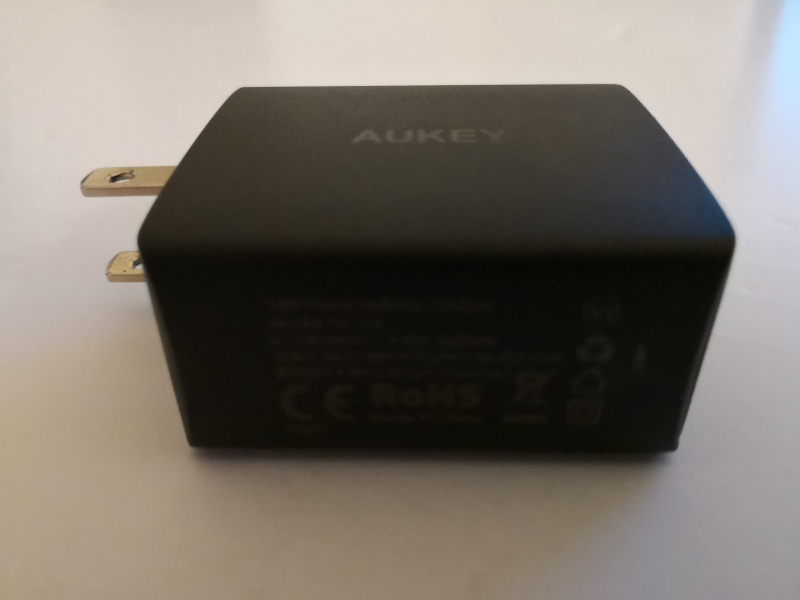The AUKEY PA-Y15 Amp 18W PD 3.0 USB-C Wall Charger is a single USB Type-C port wall charger that can take advantage of USB Power Delivery 3.0 technology to output up to 18W of charging to your phone or tablet. The charger supports Power Data Objects (PDO) protocol negotiation through PD 3.0 using 15 watts (5 volts @ 3 amps) and 18 watts (9 volts @ 2 amps) power profiles as well as Programmable Power Supply (PPS) of both 3-5.9 volts @ 3 amps and 6-11 volts @ 2 amps. In case you need higher power for faster charging, you can use a similar charger like the AUKEY PA-Y8 PD 3.0 USB-C Wall Charger to provide 27W of charging.
By supporting USB PD 3.0, the AUKEY PA-Y15 Amp 18W PD 3.0 USB-C Wall Charger should allow more efficient charging at lower temperatures over the USB Type-C connector. Like many other Aukey products, the charger is not provided with a USB Type-C cable but only a 24-month warranty card and an instruction manual. In contrast you would normally find a included USB Type-C cable from other popular charger brands like Belkin and Ventev.
Similar to other wall chargers, this charger also has foldable ac power prongs that are used to plug in to a ac power outlet for charging.
The USB Type-C port can be used to quickly charge phones which support USB Power Delivery technology like the Apple iPhone X, iPhone 8, Samsung Galaxy Note 8, Galaxy S8, HTC 10, and LG V20 or tablets such as the Huawei MateBook. Just make sure to use the Apple USB-C to Lightning Cable to charge your iPhone with the charger.
Note Aukey also sells the AUKEY PA-Y10 Amp PD 3.0 USB-C Wall Charger which you may also consider if needing a PD 3.0 capable dual port wall charger with an additional USB Type-A port for legacy charging.
To view the power capabilities of the AUKEY PA-Y15 Amp 18W PD 3.0 USB-C Wall Charger, we used the USB Power Test App from Granite River Labs with the Granite River Labs USB Power Delivery Compliance C2 Tester to produce the following test results.
The USB Power Test App first negotiates a power contract for every PDO supported by the AUKEY PA-Y15 Amp 18W PD 3.0 USB-C Wall Charger, and increases the load gradually to find the threshold where over current protection (OCP) kicks in and voltage and current start to drop for safety reasons.
The USB Power Test App also reports out all the PDO's supported by the Aukey charger and their OCP thresholds. Notice the 4th PDO doesn't really match the 6-11 volts @ 2 amps PPS power profile listed on the charger's casing. OCP thresholds for the Aukey charger are set at about 8-14% above the maximum current levels for the fixed PDO's.
| PDO | OCP (A) |
|---|---|
| PDO#1 Fixed: 5V 3A | 3.26 |
| PDO#2 Fixed: 9V 2A | 2.28 |
| PDO#3 PPS: (3~5.9)V 3A | 2.95 |
| PDO#4 PPS: (3~11)V 2A | 1.5 |
The USB Power Test App takes this data to produce an I-V curve which graphically shows the relationship between voltage and current for each PDO. Like other chargers that support PPS (Programmable Power Supply), we can observe current fold-back behavior for the 1st, 2nd and 3rd PDO's where as the current increases beyond the OCP threshold, the voltage starts to curve down rather than immediately shutting off. The 2nd PDO exhibits more dramatic fold-back behavior compared to the other PDO's. In contrast the 4th PDO shows the voltage immediately shuts off once the current crosses the OCP threshold.
The USB Power Test App can also use the Granite River Labs USB Power Delivery Compliance C2 Tester integrated with the GW Instek APS-7100 programmable AC power supply to compare the charger's power output vs power input so that power efficiency can be measured and compared to regulatory limits from United States of Energy (DOE) Level VI or European Union's CoC Tier 2 requirements. We can repeat the power efficiency tests for different PDO's, current load conditions, and different AC input ranges, allowing us to get a complete picture of power efficiency ranges across all different usage scenarios.
 GTrusted
GTrusted



































